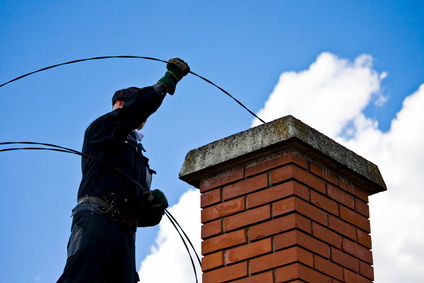The Importance of Chimney Repair
Even the slightest chimney masonry damage requires professional attention. Without it, the problem may worsen to the point that water leaks into the walls surrounding your fireplace and ruins combustible materials such as wood framing and drywall.
Fortunately, catching these issues early on can save homeowners a great deal of money and prevent dangerous problems. Keep an eye out for the following signs of chimney trouble.
Water Damage
The constant deluge of rain that often falls on a roof can cause damage to the chimney if the proper maintenance steps aren’t taken. Specifically, gaps can form around the flashing where the chimney meets the roof, which can allow water to seep inside the masonry structure and the attic or walls surrounding the chimney.
Once water has entered the masonry of a chimney, it can freeze and thaw repeatedly, causing small cracks to grow into larger ones. This cycle will eventually cause the bricks to collapse.
It is important to have a professional inspect your chimney for leaks and other damage. A professional can determine the source of your chimney leak and fix it. If you have insurance, many insurance companies will reimburse homeowners for the cost of a chimney repair once the claim is processed. To help with this process, be sure to hang onto all receipts and documents associated with your chimney repair project.
Spalling Bricks
When water damage to brick walls or chimneys is left unattended, it can quickly turn into spalling. When masonry suffers from a spalling problem, the bricks will begin to flake apart and crumble. The damage is caused by moisture which seeps in between the bricks and masonry and freezes and thaws again and again over time. This process is a lot more serious than surface-level water damage and can cause the structural integrity of your home to be compromised.
A reputable masonry company can inspect your chimney for spalling problems and repair them to prevent further deterioration. They can use a waterproof sealant to stop water from entering the cracks and help your bricks and mortar stay dry. In addition, they can replace any missing bricks and repair the mortar to make the chimney structure look uniform again. Prevention includes keeping up with yearly maintenance and regular inspections from a qualified chimney sweep. In addition, ensuring that your home has proper drainage to move moisture away from the masonry can prevent damage as well.
Cracked Chimney Lining
The chimney flue is a pipe-like section that allows smoke, carbon monoxide and other gases to move up and out of the home. A crack in the flue lining, even if it is only a small crack, presents a high-priority safety hazard because harmful gases can leak back into the house.
The clay tile liners built into most masonry chimneys do a great job for about 25 years but, over time, they deteriorate. While there are many ways to repair a cracked liner, most involve partial tear-downs and rebuilds and can be expensive.
A newer method of chimney relining uses HeatShield Cerfractory Flue Liner treatment that doesn’t require a tear-down or a rebuild and lasts for a lifetime. However, even with this amazing new technology, you still need to get your chimney inspected and swept twice each year and have the flashing sealed each winter. Chimney flashing sealants such as Saver Systems’ FlashSeal will protect the chimney and prevent leaks into your home.
Cracked Crown
A pristine chimney crown is one of the best defenses against water damage. This concrete slab sits atop the chimney, preventing water from seeping into the mortar joints and the gap between the roof and the firebox or flue tiles.
Wind, rain, snow, and the constant expansion and contraction of your chimney’s masonry will wear down the crown over time. This will eventually lead to cracks that enlarge over time. These cracks can allow moisture into the chimney, causing serious problems with the firebox, damper, and walls and ceilings of your home.
A cracked chimney crown can easily be repaired with a modern repair mix that includes masonry patch cement. Using a brush (we recommend ChimneyRx Brushable Crown Repair) apply a thin coat of the mixture to the surface of your chimney crown. Let it set before applying a second, thicker coat. Repeat as needed. It may take several hours for the chimney crown to cure completely.
